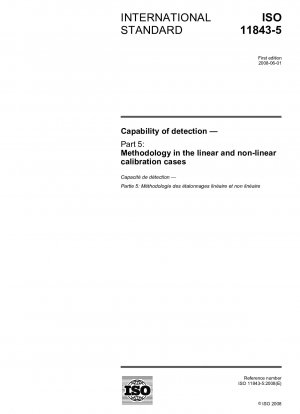ISO 11843-5:2008
Capability of detection - Part 5: Methodology in the linear and non-linear calibration cases
- Standard No.
- ISO 11843-5:2008
- Release Date
- 2008
- Published By
- International Organization for Standardization (ISO)
- Status
- Replace By
- ISO 11843-5:2008/Amd 1:2017
- Latest
- ISO 11843-5:2008/Amd 1:2017
- Scope
- This part of ISO 11843 is concerned with calibration functions that are either linear or non-linear. It specifies basic methods to -- construct a precision profile for the response variable, namely a description of the standard deviation (SD) or coefficient of variation (CV) of the response variable as a function of the net state variable, -- transform this precision profile into a precision profile for the net state variable in conjunction with the calibration function, and -- use the latter precision profile to estimate the critical value and minimum detectable value of the net state variable. The methods described in this part of ISO 11843 are useful for checking the detection of a certain substance by various types of measurement equipment to which ISO 11843-2 cannot be applied. Included are assays of persistent organic pollutants (POPs) in the environment, such as dioxins, pesticides and hormone-like chemicals, by competitive ELISA (enzyme-linked immunosorbent assay), and tests of bacterial endotoxins that induce hyperthermia in humans. The definition and applicability of the critical value and minimum detectable value of the net state variable are described in ISO 11843-1 and ISO 11843-2. This part of ISO 11843 extends the concepts in ISO 11843-2 to the cases of non-linear calibration. The critical value, Xc, and minimum detectable value, xd, are both given in the units of the net state variable. If xc and xd are defined based on the distribution for the response variable, the definition should include the calibration function to transform the response variable to the net state variable. This part of ISO 11843 defines xc and xd based on the distribution for the net state variable independently of the form of the calibration function. Consequently, the definition is available irrespective of the form of this function, whether it is linear or non-linear. The calibration function should be continuous, differentiable, and monotonically increasing or decreasing. A further method is described for the cases where the SD or CV is known only in the neighbourhood of the minimum detectable value. Examples are provided.
ISO 11843-5:2008 Referenced Document
- ISO 11843-1:1997 Capability of detection - Part 1: Terms and definitions
- ISO 11843-2:2000 Capability of detection - Part 2: Methodology in the linear calibration case
- ISO 3534-1 Statistics — Vocabulary and symbols — Part 1: General statistical terms and terms used in probability
- ISO 3534-2 Statistics - Vocabulary and symbols - Part 2: Applied statistics
- ISO 3534-3 Statistics-Vocabulary and symbols-Part 3:Design of experiments*, 2024-04-19 Update
- ISO 5725-1 Accuracy (trueness and precision) of measurement methods and results — Part 1: General principles and definitions*, 2023-07-01 Update
ISO 11843-5:2008 history
- 2017 ISO 11843-5:2008/Amd 1:2017 Capability of detection - Part 5: Methodology in the linear and non-linear calibration cases; Amendment 1
- 2008 ISO 11843-5:2008 Capability of detection - Part 5: Methodology in the linear and non-linear calibration cases
